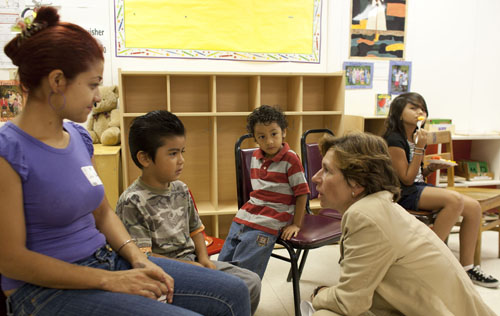
A tanári szakma válaszút előtt áll. Az Egyesült Államoknak lehetősége van arra, hogy megreformálja az egész szakmát, és a tanítást ne csak Amerika egyik legfontosabb szakmájává tegye, hanem Amerika egyik legelismertebb szakmájává is. De először kölcsön kell kölcsönöznünk néhány nagyszerű ötletet a világ sikeres oktatási rendszereitől, amelyek már elérték ezt.
Michael Fullan és Andrew Hargreaves ihlette’ új könyv, Szakmai Capital, “A Global Search for Education: In Search of Professionals – Rész 1” elkezdte megvizsgálni, hogyan nézhet ki az amerikai tanárok következő generációja. Ma folytatjuk ezt a beszélgetést valakivel, aki mindenkinél jobban érti, hogy a szakmai kiválóság miért az egyik leglényegesebb befektetés, amit gyermekeink jövőjébe tehetünk.. Ez a személy Randi Weingarten, Elnöke az American Federation of Teachers.
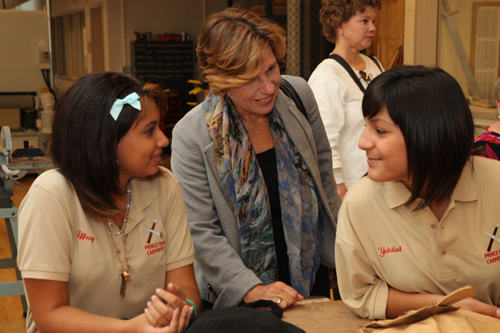
Milyen lépéseket kell megtennünk Hargreaves és Fullan örökbe fogadása érdekében? “tanítani, mint egy profi” akcióterv?
Minden kérdésre kollektív munkának kell tekintenünk, nem egyéni munkának. Ez egy egészen más mentalitás az Egyesült Államokban.
Tisztelnünk kell a tanárokat. Ha valaki nem végez jó munkát, akkor lehet tisztelni őt, de tudatni is kell vele, hogy valamit tenni kell a problémával..
Az Egyesült Államokban a legnagyobb probléma az a ijesztő körülmények, amelyek között sok tanár dolgozik. A tanáraink fele az elsőben távozik 3 a 5 évek a munkában. Hargreaves és Fullan megjegyzi, hogy ahhoz, hogy befektetésünk még most is megtérüljön, a tanároknak legalább a munkahelyen kell maradniuk. 8 év. Ez az erőforrások és az agyerő hatalmas pazarlása, ami kimegy az ajtón. A tanárok lemorzsolódása elleni küzdelem valószínűleg a legfontosabb probléma. Arra is ki kell térnünk, hogy mit tehetünk a tanárok képzésével kapcsolatban, mielőtt elkezdenék a szakmát. Ezt további fejlesztéssel és támogatással kell követni, amikor a tanárok dolgoznak. Más mentalitásra van szükségünk, azaz. a tanárok nem egyszerűen születnek, a tanárokat nevelni kell. Azt mondjuk, az ifjúság nevelése a legfontosabb, amit a jövő szempontjából teszünk. Egy lélegzetvétellel nem mondhatjuk, hogy rendben van, ha csak beugratunk valakit az osztályterembe, és azt mondjuk, “Menj, csináld. Az év végén értékeljük Önt gyermekei teszteredményei alapján.”
Mi a véleménye a szabványosított tesztelésről az Egyesült Államokban a diákok és a tanárok tekintetében??
Azt hiszem, túlságosan ragaszkodunk a szabványosított tesztekhez. A tesztelésnek megvan a maga szerepe. Fontos, hogy metrikus pálcaként segítsen a gyerekeknek megérteni, mit tudnak és mire képesek. A tanárok és mások számára fontos, mert tájékoztat az oktatásról. Eszközként használható annak szemléltetésére, hogy hol vannak erősségek és hol gyengeségek. Mi történt az Egyesült Államokban, ellentétben a világ szinte bármely más országával, az, hogy kilógunk az összhangból, ami azt jelenti, hogy a teszteknek több következménye van a tanárokra nézve, mint a diákokra nézve. Újra kell egyensúlyoznunk. A probléma része az is, hogy a tesztelés a szakmánk alapvető deprofesszionalizálódásáig nyúlik vissza. Mindig keresni kell a gyors megoldást, az ezüstgolyót, azt az érzést, hogy egyetlen beavatkozásra van lehetőség, amely teljesen pozitív irányba változtatja az oktatást. Ez nem történik meg. A gyors megoldás korábban egy tanári tananyag volt. Most a gyors megoldás az, ha csak a teszteredményeket használjuk mindennek, és mindennek vége, tudni fogjuk, hogy jó úton járunk-e vagy sem. A minket felülmúló országok megértik, hogy a tanárok az elme orvosai. We should be working on creating a climate that is conducive to teaching and learning.
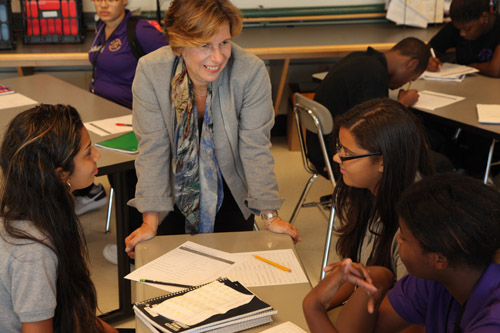
What changes in the teaching profession need to be made in order to address the achievement gap with the 20% of children in the US that are from poor families?
The achievement gap between rich and poor is greater than the achievement gap between black and white. Van egy 40% achievement gap between rich and poor. What we are seeing more and more is that the socio-economic obstacles are very daunting and yet we have an absolute obligation to try to address them. We cannot ignore them. There are several things that have to happen:
Training Training Training.
Support Support Support — once teachers-in-training become teachers.
The countries that outperform us understand that people really have to be prepared to teach in the current environment versus the way teachers were prepared to teach 20 vagy 30 évvel ezelőtt.
We need to be very prepared to teach 21st century skills, which is not about simply knowing things. It’s also about knowing how to apply knowledge, how to critically think, how to problem solve and how to work with others. Those things are as important. Some of that is training. Some of that is working together and some of that is discovered on the job itself.
What can we do now about getting star teachers into poor schools?
I think you can do several things and I speak from my own personal experience when I was teaching in the Chancellor’s district in New York City. We had a multi-faceted strategy to turn around poor performing schools into performing schools. We did many things at the same time.
We really focused on the capability of the teaching force. We only accepted certified teachers and we made sure they were supported. We built in extra time to train teachers on an ongoing basis and created a curriculum that everybody bought into and trained on. For these particular schools, the curriculum we used in both literacy and math was used schoolwide. Professional development was aligned with curriculum. We also built in additional time for kids so that if they were falling behind, they got immediate tutoring in the areas in which this was happening. We had more parental outreach. Teachers had a choice to stay in these particular schools, and in exchange for their additional time, for making the choice to stay, and for using the approved curriculum, they got paid an additional 15%. We didn’t have a problem with attrition and we saw in a couple of years that all students in the elementary school had been turned around. We created schools where parents wanted to send their kids and teachers wanted to teach. We had leadership that was collaborative and supportive. We had the tools and conditions to get the job done. If you have all these things, whatever the neighborhood and whatever the environment, experienced teachers will stay.
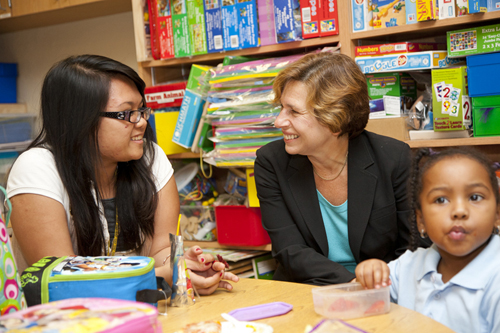
As we move forward into the 21st century, technology continues to play a larger role in teachers’ és a diákok’ életét. What are the positive and negatives of technology with regard to improving student learning and assisting teacher training?
One of the biggest challenges teachers face is personalizing and differentiating instruction to meet the needs of all the students in their classrooms. Digital resources and technological tools have tremendous promise to assist in that. Plusz, technology offers ways to provide extra supports for struggling students, for extending learning beyond textbooks, and for providing access to engaging content. It can be tremendously empowering of both teachers and students. But we have to remember that really integrating technology into the curriculum requires more, not less of teachers. So we really have to make sure that they have the time, szakmai fejlődés, equipment, and technical support they need to take advantage of that potential for their students. And we can’t forget that while the digital divide is narrowing, it’s still very real. Reliable internet access and bandwidth are still very real issues in too many of our urban and rural communities. Így, whether you are talking about student learning or teacher training, it’s not the tool — the technology — it’s how you use it. And it matters whether you have the conditions and support to use it well.
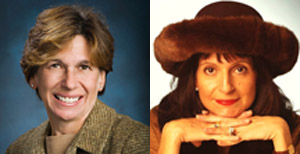

A globális keresési Oktatási, velem és világszerte elismert szellemi vezetők többek között Sir Michael Barber (UK), DR. Michael blokk (US), DR. Leon Botstein (US), DR. Linda Darling-Hammond (US), DR. Madhav Chavan (India), Professzor Michael Fullan (Kanada), Professzor Howard Gardner (US), Professzor Yvonne Hellman (Hollandiában), Professzor Kristin Helstad (Norvégia), Jean Hendrickson (US), Professzor Rose Hipkins (Új-Zéland), Professzor Cornelia Hoogland (Kanada), Mrs. Chantal Kaufmann (Belgium), DR. Eija Kauppinen (Finnország), Államtitkár Tapio Kosunen (Finnország), Professzor Dominique Lafontaine (Belgium), Professor Hugh Lauder (UK), Professor Ben Levin (Kanada), Professzor Barry McGaw (Ausztrália), Shiv Nadar (India), Professzor R. Natarajan (India), DR. Denise Pope (US), Sridhar Rajagopalan (India), DR. Diane Ravitch (US), Sir Ken Robinson (UK), Professzor Pasi Sahlberg (Finnország), Andreas Schleicher (PISA, OECD), DR. Anthony Seldon (UK), DR. David Shaffer (US), DR. Kirsten Magával ragadó Are (Norvégia), Chancellor Stephen Spahn (US), Yves Theze (Lycee Francais US), Professor Charles Ungerleider (Kanada), Professzor Tony Wagner (US), Sir David Watson (UK), Professzor Dylan Wiliam (UK), DR. Mark Wormald (UK), Professzor Theo Wubbels (Hollandiában), Professzor Michael Young (UK), és professzor Minxuan Zhang (Kína) mivel azok feltárása a nagy kép oktatási kérdés, hogy minden nemzet ma szembesül. A Global Search Oktatási közösségi oldal
C. M. Rubin a szerző két legolvasottabb internetes sorozat, amely megkapta a 2011 Upton Sinclair díjat, “A Global Search for Education” és “Hogyan fogjuk olvasása?” Ő a szerzője a három bestseller könyv, Beleértve The Real Alice Csodaországban.

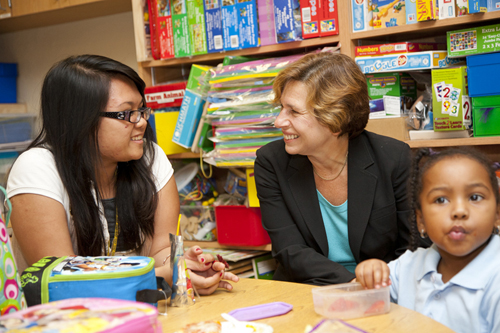
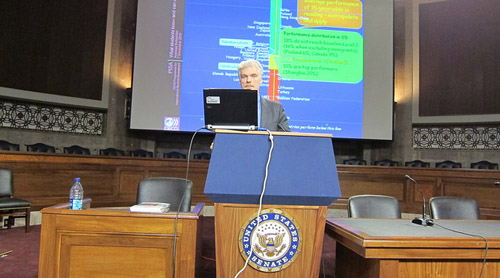
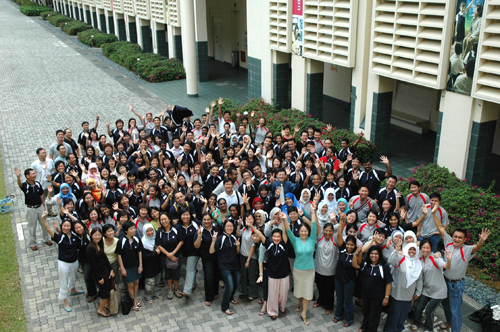
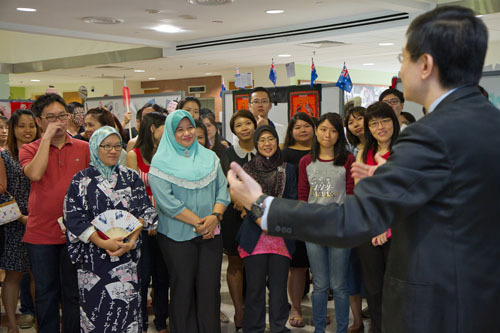
Legutóbbi hozzászólások